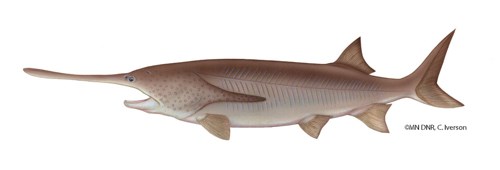
(c) MN DNR, C. Iverson IntroductionPaddlefish are built for feeding. With a paddle-like snout and toothless, beachball-sized mouth, the paddlefish can hardly be mistaken for any other fish in the Mississippi River. A true large river fish, it has no predators as an adult and can grow to more than 7 feet in length. Paddlefish feed exclusively on plankton. It swims into the mass of microorganisms with its mouth wide open, straining the tiny creatures through special rakers in its gills. Its snout contains special sensors the fish uses to locate electrical currents emitted by huge schools of zooplankton. Once common in the Mississippi River, numbers declined sharply due to overharvest. Its population is now making a slow but steady recovery. By 2009, commercial harvesters and sport anglers reported incidental catches with increasing frequency but still far below historic levels. The state of Minnesota still identifies it as an endangered species due to loss of spawning grounds, overfishing and pollution. Paddlefish are long-lived species, surviving for at least 20 years. However, mature fish probably do not reproduce every year, adding to the challenge of recovery. Fascinating Facts
IdentificationKey ID Features: The distinctive feature of a paddlefish is its paddle-like snout (rostrum). Paddlefish have bluish to dark gray back and sides, a white belly, and smooth skin that lacks all but a few tiny scales. Its long gill flap reaches back nearly to the middle of the body. This large fish runs 24-48 inches in length and 30-50 pounds. For Further Reading
|
Last updated: November 22, 2019
